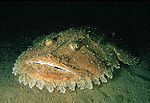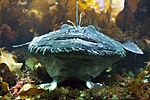Monkfish facts for kids
Quick facts for kids Monkfish |
|
|---|---|
 |
|
| Scientific classification |
|
| Kingdom: | Animalia |
| Phylum: | Chordata |
| Class: | Actinopterygii |
| Order: | Lophiiformes |
| Family: | Lophiidae |
| Genus: | Lophius Linnaeus, 1758 |
| Type species | |
| Lophius piscatorius Linnaeus, 1758
|
|
| Species | |
|
See text |
|
Monkfish are a type of anglerfish found in the Atlantic and Indian Oceans. They are also known by other names like "fishing-frogs," "frog-fish," and "sea-devils." Fishermen in the North Sea and North Atlantic often call them "monk" or "monkfish."
There are different kinds of monkfish. For example, Lophius piscatorius is found in Northern Europe, and Lophius budegassa lives in the Mediterranean Sea.
Species of Monkfish
Here are the seven types of monkfish known today:
| Image | Scientific Name | Common Name | Where They Live |
|---|---|---|---|
 |
Lophius americanus | American angler | Western Atlantic, from Newfoundland down to northern Florida |
 |
Lophius budegassa | Blackbellied angler | Eastern Ionian Sea and inshore waters of the United Kingdom |
| Lophius gastrophysus | Blackfin goosefish | Coasts of northern South America, Central America, Aruba, Cuba, and Costa Rica | |
| Lophius litulon | Yellow goosefish | Japan, Korea, and the Yellow and East China seas | |
 |
Lophius piscatorius | Angler | Northeast Atlantic, from the Barents Sea to the Strait of Gibraltar, the Mediterranean and the Black Sea |
| Lophius vaillanti | Shortspine African angler | Eastern Atlantic | |
| Lophius vomerinus | Devil anglerfish | Durban, South Africa, and northern Namibia in the Indian and Atlantic Oceans |
Monkfish Description
Monkfish have a very large, wide, and flat head. The rest of their body looks much smaller, almost like an attachment. Their huge mouth goes all the way around the front of their head. Both their upper and lower jaws have many long, sharp teeth that point inwards. These teeth can lie flat to let prey slide in, but they quickly pop up to stop anything from escaping.
Their fins, especially the pectoral and ventral fins, work like feet. This allows the monkfish to "walk" on the ocean floor. They often hide in the sand or among seaweed. Their skin around the head and body has frilly bits that look like short pieces of seaweed. These frills, along with their ability to change color to match their surroundings, help them hide very well. They choose hiding spots where there are lots of other fish to eat.
Monkfish have three long, thin parts sticking out from the middle of their heads. These are actually changed parts of their front dorsal fin. The longest one is the first, and it has a fleshy, irregular growth at its end called the esca or illicium. This part can move in any direction. Monkfish use this modified fin ray like a fishing lure to attract other fish. When a fish comes close, the monkfish quickly opens its huge jaws and swallows the prey whole. The monkfish's jaws snap shut automatically if something touches the esca.
Like most anglerfish, monkfish have a stomach that can stretch a lot. This means they can swallow prey that is as big as they are! Monkfish can grow to be over 150 centimeters (about 5 feet) long. It's common to find them around 100 centimeters (about 3 feet) long.
Monkfish Reproduction
Monkfish lay their eggs in a thin, clear, jelly-like sheet. This sheet can be about 60 to 100 centimeters (2 to 3 feet) wide and 8 to 10 meters (26 to 33 feet) long. The eggs are in a single layer, each in its own small space within the sheet. This egg sheet floats freely in the sea. When the eggs hatch, the baby monkfish (larvae) swim freely and have long, thin parts on their pelvic fins.
Monkfish Habitat
The monkfish species found in the East Atlantic lives along the coasts of Europe, but they are less common north of 60°N latitude. They also live off the coasts of the Cape of Good Hope in Africa. The species caught on the North American side of the Atlantic is usually Lophius americanus. Another species, Lophius budegassa, lives in the Mediterranean Sea, and L. setigerus is found off the coasts of China and Japan.
Two common types of monkfish, the black anglerfish (L. budegassa) and the white anglerfish (L. piscatorius), live in both shallow waters (around 800 meters or 2,600 feet deep) and much deeper waters (over 1,000 meters or 3,300 feet deep). These two species look very similar. The main differences are the color of their belly lining (black for L. budegassa and white for L. piscatorius) and the number of rays in their second dorsal fin.
Black anglerfish tend to live more to the south, in the Mediterranean and the eastern North Atlantic from the British Isles to Senegal. White anglerfish live further north, in the Mediterranean, Black Sea, and eastern North Atlantic from the Barents Sea to the Strait of Gibraltar. Even with these differences, their living areas often overlap a lot.
Both black and white anglerfish are important because people catch them for food using fishing methods like trawling and gillnetting.
There are some worries about whether monkfish fishing can continue without harming the fish population. The most common way to catch monkfish, called beam trawling, can damage the habitats on the seafloor. Because of these concerns, some stores, like the British supermarket chain Asda, stopped selling monkfish in 2007.
See also
 In Spanish: Rapes para niños
In Spanish: Rapes para niños

